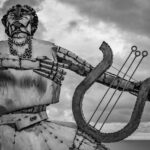Apophis: The Great Serpent in Ancient Egyptian Mythology
Apophis, known in ancient Egyptian culture as Apep, symbolizes the Great Serpent and stands as the nemesis of the sun god Ra. In this religious context, Ra’s heavenly vessel traverses the sky from dawn until dusk, subsequently descending into the underworld. However, during this nighttime journey, Apophis attempts to vanquish Ra and obstruct the dawn.
Within Ra’s celestial barque, various deities and the justified souls of the deceased are depicted across different eras, uniting to battle against the serpent. Both priests and laypeople engaged in rituals aimed at reinforcing Ra’s defenses while striving to eliminate Apophis. These ceremonies served to connect the living with the deceased and to uphold the natural hierarchical order set forth by the gods.
Despite not possessing a dedicated cult or worship, Apophis is a recurrent figure in narratives illustrating his relentless assaults on Ra, intending to plunge the world back into chaos. He is associated with phenomena such as earthquakes, storms, darkness, and death, and is often linked to the god Set, who also represents disorder and chaos. While Set was initially a protective deity, he was frequently depicted as the most powerful of Ra’s allies during the confrontations against Apophis on the sun god’s ship.
Although stories of serpentine adversaries likely existed prior to Apophis’s official mention, he first emerges in Middle Kingdom writings (2040-1782 BCE). His notoriety persisted into the Late Period of Ancient Egypt (525-332 BCE), and even into the Ptolemaic (323-30 BCE) and Roman periods. Most references to Apophis originate from the New Kingdom era (c. 1570-1069 BCE), particularly in The Book of Overthrowing Apophis, a text detailing rituals and spells designed for vanquishing the serpent. This text is widely recognized among the Execration Texts, which were used for cursing individuals or entities throughout Egyptian history.
Imagery and Defenses Against Apophis
Visually, Apophis is frequently represented as a coiled serpent, yet he is often depicted as dismembered or under siege. A notable portrayal arises from Spell 17 of The Egyptian Book of the Dead, where a sacred cat named Mau slays Apophis with a knife. Mau is believed to personify the sun god and safeguard the Tree of Life, holding the keys to eternal life and divine wisdom. The imagery from the tomb of Inerkhau, highlighted by Egyptologist Richard H. Wilkinson, illustrates Mau fiercely attacking Apophis while defending the Tree of Life, embodying Ra’s protective essence during the New Kingdom.
Mythological Roots
The predominant creation myth features the god Atum, who emerges upon the primordial mound, surrounded by chaotic waters, and initiates creation. Accompanied by Heka, the embodiment of magic, Atum brings forth order and a new dawn through magical means. An alternative version claims that the goddess Neith also plays a crucial role in creation, exhibiting the same partnership with Heka. Apophis first appears in these myths, symbolizing chaos and disorder.
In Atum’s creation narrative, Apophis, who predated creation, resided in the dark waters of chaos. His animosity arises from the introduction of order—an antithesis to his essence. With creation, duality emerges; thus, Apophis stands against Ra, as the sun signifies divine order, light, and life. Should he consume the sun god, he could revert the world back into chaos.
Conversely, in Neith’s creation account, Apophis is a created being born alongside the ordered universe. Although he is not a primordial deity, he aims to restore the chaotic state that existed before creation.
The Struggle of Order Against Chaos
The conflict between Apophis and the gods encapsulates the eternal struggle of order represented by the deities against the chaos embodied by Apophis. This theme of order versus chaos was prominent in the Middle Kingdom literature, notably seen in works like the Admonitions of Ipuwer, that reflect upon the dichotomy of the chaotic present versus a perceived golden past.
The Apophis myth serves to illustrate how gods, the custodians of order, rely on human agency to protect life from darkness and chaos, emphasizing the importance of individual identity in Egyptian culture. Apophis symbolizes humanity’s deepest fears: dread, oblivion, and the potential loss of unique identity.
Rituals for Overthrowing Apophis
Ancient Egyptians perceived nature as infused with divinity, particularly the life-giving sun. Eclipses and overcast days evoked concern over Ra’s capability to lift his vessel back into the sky—often attributed to Apophis’s influence. During the latter New Kingdom, The Book of Overthrowing Apophis was created, detailing rituals involving the most feared deities to combat the chaos serpent. Priests employed figurative representations of Apophis which they cursed and destroyed through various methods.
Despite numerous defeats, Apophis always resurrected to initiate another assault on Ra’s vessel. The gods would emerge victorious each night, but with daylight’s arrival, Apophis would regenerate, ready to challenge Ra again by sunset. The Book of Gates recounts how goddesses such as Isis, Neith, and Serket, along with other deities, captured Apophis, imprisoning him in nets held down by divine monkeys and the earth god Geb, only for him to regrow overnight.
Even though the gods wielded tremendous power, they required assistance from both the justified deceased and the living. The Coffin Texts contained spells to empower the dead in aiding Ra’s defense. Set regularly spearheaded the effort against Apophis, while the serpent god Mehen also joined to offer protection. The board game Mehen traces its origins back to this mythological context reflecting Mehen’s defense role. Additionally, the rituals involved the living, casting wax figures of Apophis that they would desecrate, reinforcing the need for constant vigilance against darkness.
At dawn, the priests would perform the initial ritual of Lighting the Fire, symbolizing the resurrection of the sun, countering Apophis’s intent to engulf the light. The subsequent ritual, Drawing the Bolt, aimed to awaken the god from slumber, summoning him to defend against the serpent once again.
Conclusion
Rituals focused on Apophis sustained importance throughout the Late Period and even into Roman times. Not solely centered on Apophis, these rituals encapsulated the broader struggles against darkness. During festivals, such as the Sed Festival, participants enacted mock battles representing the eternal conflicts between order and chaos.
These cultural practices affirmed humanity’s essential role within the cosmos. The sun represented not just a celestial body but an entity carrying profound characteristics and significance, requiring constant reinforcement from both the divine and human realms to secure life’s continuity. The mythos of Apophis highlights the continual battle between light and dark, underlining that humans are not merely passive observers but active participants in the divine plan, a notion that lingered until the advent of Christianity in the 4th century CE.
As Christianity rose, the traditional view of humanity serving alongside deities shifted to a more dependent relationship. Apophis’s narrative, however, persisted in later Christian contexts, merging various mythological figures into the embodiment of evil, showcasing the enduring legacy of ancient beliefs.




